This was published 6 years ago
St Petersburg to Moscow, Russia: A river cruise through world's biggest country
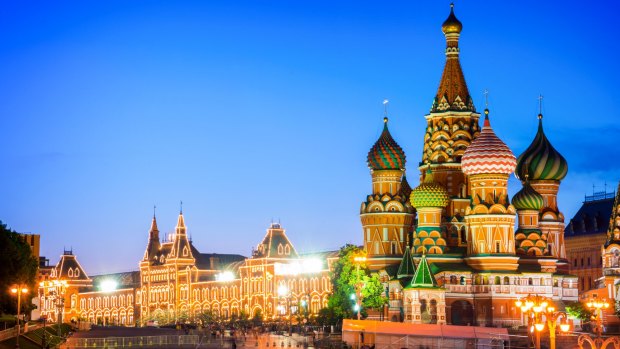
St Basil's Cathedral on Red Square, Moscow.Credit: Alamy
There are a few nervous giggles as six women from assorted countries strip off in preparation for our first banya, the Russian version of a sauna. We don unflattering felt hats and white sheets while our strapping attendant Dmitri stokes the fire with birch logs to heat the steam room. "Sheets are only for foreigners," he says, "we use banyas naked."
We sit on wooden benches, sweat pouring in the aromatic heat, while Dmitri beats us in turn with a bunch of birch leaves – gently fluttering around the face and neck, more firmly on arms and legs. It is deliciously relaxing and then there's a shocking wake-up call when he tips a bucket of ice-cold water on our heads. That's just a prelude to tripping outside in our soaking sheets to receiving a full-body drenching in freezing water from the river just outside the banya. We take a quiet, slightly stunned, break for tea and jam, then repeat the ritual.
We are in Mandrogy, a reconstructed traditional village on the banks of the Svir River. Our sturdy rivership, Viking Ingvar, has sailed 17 hours along the Neva River and across Lake Ladoga (the biggest freshwater lake in Europe) from St Petersburg; we need this time – and the banya experience – to absorb the impact of three days' intense sightseeing in Russia's dazzling cultural capital.
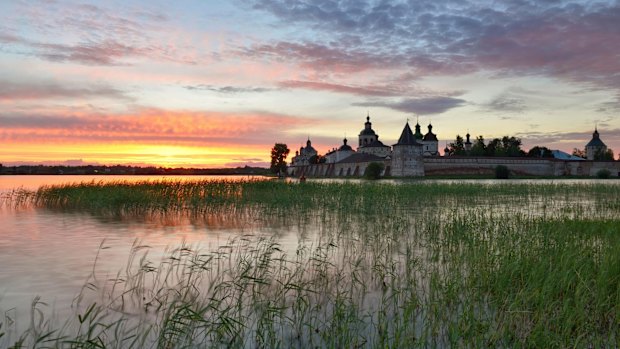
Sunset near the Kirillo-Belozersky monastery, Kirillov, Vologda region, Russia.Credit: Alamy
Among the personal highlights of visiting St Petersburg are seeing two ballets in two days; Swan Lake at the Hermitage Theatre, which is included in the cruise, and a sublime performance of Romeo and Juliet at the Mariinsky Theatre, staged in one of the city's most celebrated historic buildings.
Then there's the Hermitage itself. Expect to be overwhelmed by this opulent, gilded palace and its vast collection of artworks – apparently if you spend one minute at each public exhibit it would take nine years to see them all. Catherine Palace in Pushkin, 24 kilometres south of St Petersburg, is another eye-opener. Set within a magnificent formal park on a lake, this extravagant blue, white and gold summer palace was a pet project of Empress Elizabeth, who ruled Russia from 1741 to 1762. Elizabeth was renowned for her love of excess – when she died, more than 16,000 dresses were reportedly discovered at this palace alone.
The Great Hall is a vast, windowed space slathered in baroque gold carvings – a fitting venue for imperial and latter-day celebrity parties – and the original lavish Amber Room was re-created over 20 years at a cost of $US12 million. "No wonder there was a revolution," mutters one member of our tour group.
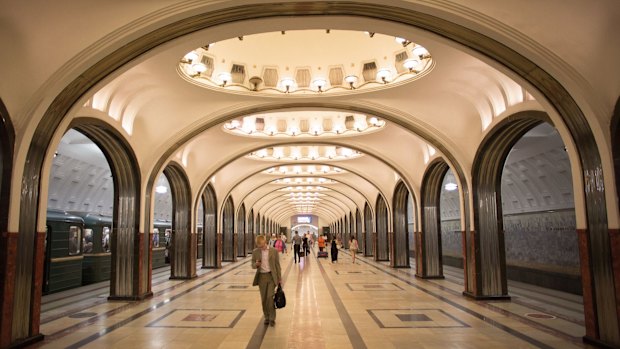
The Moscow Metro underground railway station is one of many ornate stations worth exploring.Credit: Erbil Balta
Sailing north along the Svir River from Mandrogy we reach Kizhi Island, in the middle of Lake Onega, early in the morning. The autumnal chill begins to bite as we walk around the collection of historic wooden buildings that make up this picturesque open-air museum. A peal of bells rings out from the 18th-century bell tower, part of the Kizhi Pogost that includes the 22-dome Transfiguration Church and adjoining Church of the Intercession (heated for winter worshippers).
Apart from being constructed without a single nail, the Transfiguration Church features a wonderful iconostasis (icon screen) – one of many we see during the cruise. Equally fascinating is wandering around a farmhouse that's furnished with the trappings of 19th-century life – here we learn about the significance of the "red corner", a space dedicated to the householders' favourite icon – it still features in many modern Russian homes.
Sailaway from Kizhi is marked by a champagne and caviar tasting – yes, at 10.30am. Hotel manager Antonino demonstrates his skill at sabrage, slicing the tops off champagne bottles with a sword and gleefully chucking the corks into the river. When we've sipped and sampled, Sacha the effervescent cruise director leads an entertaining Russian language lesson in the Sky Bar.
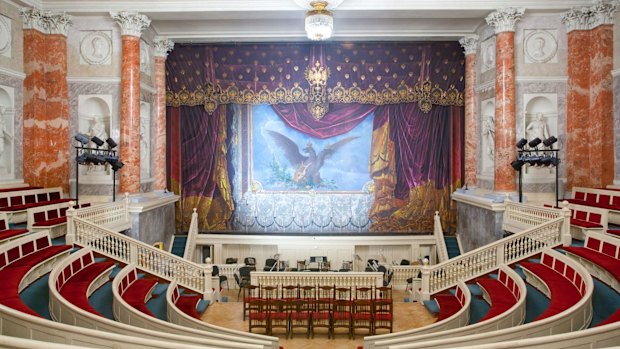
The Hermitage Theatre adds to the cultural richness of St Petersburg.Credit: Alamy
Sacha must be one of the hardest-working cruise directors I've met. Not only does he present excellent lectures on Russian history, politics and culture, he accompanies shore tours, hosts the late-night music and trivia shows and is available at all hours to answer any passenger queries.
Other onboard activities we enjoy during the cruise include a vodka-tasting session, complete with detailed printed notes; a demonstration by executive chef Joachim on making pelmeni, delicious meat-filled dumplings; a galley tour; Russian wine-tasting; and a Q&A with the affable Captain Igor Stepanov.
From the tiny river port town of Kuzino we have an afternoon tour that takes in the medieval Kirillo-Belozersky Monastery, on the shores of Lake Siverskoye, and a visit to a local high school. We learn a lot at both places.
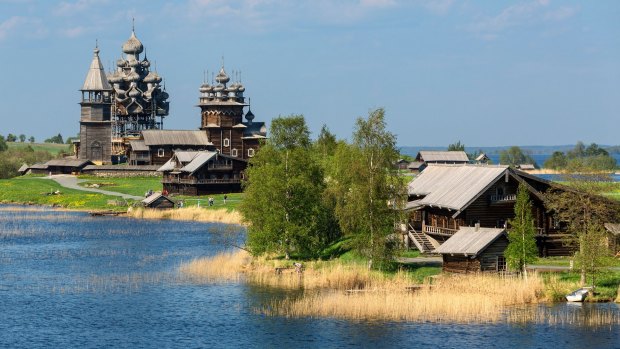
Kizhi Island, Russia, features a collection of historic wooden buildings.Credit: Alamy
The fortified monastery is a magnificent complex of 11 churches built between the 15th and 17th centuries – at one time it was the second-richest landowner in Russia. Our lovely, soft-voiced guide Marina explains the symbols and colours used in the icons (some are 600 years old and have been exhibited at the Guggenheim in New York), frescoes and vestments on display.
At the school, students perform folk songs and later, in a classroom, we marvel at the poise of the articulate 14-year-old girl who tells us about local life in fluent English. An example: the lake is still used for washing clothes because 30 per cent of nearby houses have no running water.
We glean more insights into contemporary Russian life when we visit Mischa and Helen's house near Uglich. Guide Irina looks like Meryl Streep and translates conversations with our hosts over breakfast. We eat Helen's home-pickled cucumbers, local cheese, black sourdough bread and cake with home-made apple jam; Mischa serves up his potent moonshine and we make several toasts to friendship.
Like Yaroslavl, the one-time capital of Russia, the pretty town of Uglich is part of the Golden Ring of cities. Both feature richly coloured churches topped with distinctive onion domes, elegant houses and row upon row of street vendors selling lacquered boxes, matryoshka dolls, Soviet-style memorabilia, brightly patterned shawls, amber jewellery and fur hats.
Uglich is our last port of call before the 24-hour journey to Moscow, along the Volga River and the Moscow Canal, which links the Volga to the Moscow River. We sail past vast swathes of forest, the 72-metre-high statue of Mother Volga and through 11 locks before docking at the North River Terminal.
Almost immediately we set off for an eight-hour guided tour, by metro and on foot, which gives a great overview of this mighty metropolis. We see several of the extraordinarily ornate metro stations, first built under the Stalinist regime; later, having looked around St Basil's Cathedral, armed police usher everyone behind barricades as they clear the famous Red Square. Speculation is rife: is it because it's Vladimir Putin's birthday? Or because the King of Saudi Arabia is in town? Not even our Russian Viking guides can find an answer. The day is topped off with a polished performance of folk music and dance – the artists are young and display a wonderful sense of humour.
My cruise companion and I spend the following days exploring the city on our own. It is surprisingly easy to navigate; the vibe is busier than in St Petersburg, the weather warmer, and it is an equally rich feast for the senses. We leave Moscow feeling privileged to have visited this richly complex, culturally intense country and as always at the end of a cruise, wish we could linger longer.
TRIP NOTES
MORE
GETTING THERE
Emirates operates three flights daily from Sydney and Melbourne to Dubai, with connections to St Petersburg and two to Moscow. Phone 1300 303 77, see emirates.com/au/english
CRUISING THERE
Viking operates 13-day Waterways of the Tsars itineraries between St Petersburg and Moscow, on five ships, from May to October in 2018. From $7895. Phone 138 747, see vikingrivercruises.com.au
Sally Macmillan travelled as a guest of Viking River Cruises and Emirates.
FIVE THINGS TO KNOW ABOUT RUSSIA
BACKGROUND READING
If you don't have time to read War and Peace, check out these titles before you go: The Siege, by Helen Dunmore (a novel about the Leningrad siege, from 1941 to 1944); Gorky Park, by Martin Cruz Smith (a crime classic set in Cold War Moscow); and Black Square: Adventures in the Post-Soviet World, by Sophie Pinkham (the journalist's account of 10 years spent in Russia and Ukraine).
WHITE NIGHTS
St Petersburg celebrates its long summer days between the end of May and mid-July with outdoor concerts and star-studded performances at the Conservatoire and Mariinsky and Hermitage Theatres. Ballet, opera and classical music take centre stage at the Stars of the White Nights Festival. See mariinsky-theatre.com/festival
THE COLOUR RED
Red Square has nothing to do with communism – the Russian word for red, "krasnyi'', originally meant "beautiful" or "good". Russian houses traditionally had a red corner, where icons were displayed and worshipped.
ST PETERSBURG, AKA…
Since the city was established by Tsar Peter I as the capital of the Russian Empire in 1703 (displacing Moscow, which became the capital again in 1918), it has been renamed several times. During World War I it became Petrograd, in 1924 it was called Leningrad and in 1991 it reverted to St Petersburg when the communist regime ended. Locals call it "Piter".
MOSCOW METRO
It's been called the most beautiful subway system in the world – with good reason. Among its 200-odd stations are 44 that are adorned with sculptures, chandeliers, marble pillars, ornate paintings and stained glass panels. Skip a museum visit and spend the time exploring the underground "palaces for the people".
Sign up for the Traveller Deals newsletter
Get exclusive travel deals delivered straight to your inbox. Sign up now.